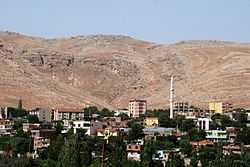Silvan, Diyarbakır
| Silvan | |
|---|---|
 | |
 Silvan | |
| Coordinates: 38°08′32″N 41°00′05″E / 38.14222°N 41.00139°ECoordinates: 38°08′32″N 41°00′05″E / 38.14222°N 41.00139°E | |
| Country | Turkey |
| Province | Diyarbakır |
| Government | |
| • Mayor | Fadıl Erdede (BDP) |
| • Kaymakam | Doğan Demirdaş |
| Area[1] | |
| • District | 1,397.14 km2 (539.44 sq mi) |
| Population (2012)[2] | |
| • Urban | 43,676 |
| • District | 86,450 |
| • District Density | 62/km2 (160/sq mi) |
| Post code | 21640 |
| Website | www.silvan.bel.tr |
Silvan (Turkish: Silvan, Ottoman Turkish: ميا فارقين Meyafarikîn,[3] Arabic: ميافارقين, Meiafarakin or Mayyafariqin; Armenian: Նփրկերտ, Np'rkert; Greek: Mαρτυρόπολις, Martyropolis; Kurdish: Farqîn; Syriac: ܡܝܦܪܩܝܛ, Mayperqiṭ) is a city in the Diyarbakır Province of Turkey. Its population is 41,451.[4]
History
Silvan has been identified by several scholars as one of two possible locations (the other being Arzan) of Tigranakert (Tigranocerta), the ancient capital of the Kingdom of Armenia, which was built by King Tigran the Great (ruling 95-55 BCE) and named in his honor.[5][6] In 69 BCE, the army of Republican Rome defeated Tigran's troops in the battle of Tigranocerta. The city lost its importance as a thriving center for trade and Hellenistic culture in the following decades. In 387 CE, with the Peace of Acilisene, Tigranakert was made part of the Byzantine Empire.
Around 400 CE, the city's bishop, Marutha (later, saint Maruthas), brought a large number of relics back from Sassanid Persia. These were relics of Christian martyrs persecuted under Sassanid rule. For this reason it was renamed Martyropolis, "city of the martyrs." Following the reforms of Justinian I (in rule 527-565), the city was made the capital of the province of Fourth Armenia.[7] It was known by the name of Meiafarakin after the Arabs took over this region in the seventh century. It declined in importance over the centuries and had been reduced to a small settlement by the twelfth century.
Notable sites
Notes
- ↑ "Area of regions (including lakes), km²". Regional Statistics Database. Turkish Statistical Institute. 2002. Retrieved 2013-03-05.
- ↑ "Population of province/district centers and towns/villages by districts - 2012". Address Based Population Registration System (ABPRS) Database. Turkish Statistical Institute. Retrieved 2013-02-27.
- ↑ Tahir Sezen, Osmanlı Yer Adları (Alfabetik Sırayla), T.C. Başbakanlık Devlet Arşivleri Genel Müdürlüğü, Yayın Nu 21, Ankara, p. 365.
- ↑ Statistical Institute
- ↑ Avdoyan, Levon. "Tiganocerta: The City 'Built by Tigranes'" in Armenian Tigranakert/Diarbekir and Edessa/Urfa. Richard G. Hovannisian (ed.) UCLA Armenian History and Culture Series: Historic Armenian Cities and Provinces, 6. Costa Mesa, CA: Mazda Publishers, 2006, pp. 94-95.
- ↑ (Armenian) Hakobyan, Tadevos Kh. «Տիգրանակերտ» (Tigranakert). Armenian Soviet Encyclopedia. vol. xi. Yerevan: Armenian Academy of Sciences, 1986, pp. 699-700.
- ↑ Adontz, Nicholas (1970). Armenia in the Period of Justinian: The Political Conditions Based on the Naxarar System. Trans. Nina G. Garsoïan. Lisbon: Calouste Gulbenkian Foundation. p. 134.
Further reading
- Amedroz, H. F. "The Marwanid Dynasty at Mayyafariqin in the Tenth and Eleventh centuries AD," JRAS, 1903, pp. 123–154.
- Minorsky, Vladimir. "Caucasica in the History of Mayyafariqin." BSOAS, Vol. 13, No. 1 (1949), pp. 27–35.
| ||||||||||||||||||||||||||||||||||||||||||||||||||||||
